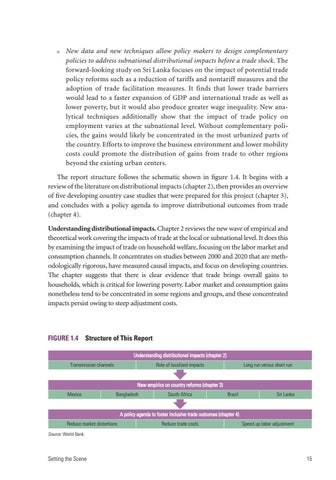■
New data and new techniques allow policy makers to design complementary policies to address subnational distributional impacts before a trade shock. The forward-looking study on Sri Lanka focuses on the impact of potential trade policy reforms such as a reduction of tariffs and nontariff measures and the adoption of trade facilitation measures. It finds that lower trade barriers would lead to a faster expansion of GDP and international trade as well as lower poverty, but it would also produce greater wage inequality. New analytical techniques additionally show that the impact of trade policy on employment varies at the subnational level. Without complementary policies, the gains would likely be concentrated in the most urbanized parts of the country. Efforts to improve the business environment and lower mobility costs could promote the distribution of gains from trade to other regions beyond the existing urban centers.
The report structure follows the schematic shown in figure 1.4. It begins with a review of the literature on distributional impacts (chapter 2), then provides an overview of five developing country case studies that were prepared for this project (chapter 3), and concludes with a policy agenda to improve distributional outcomes from trade (chapter 4). Understanding distributional impacts. Chapter 2 reviews the new wave of empirical and theoretical work covering the impacts of trade at the local or subnational level. It does this by examining the impact of trade on household welfare, focusing on the labor market and consumption channels. It concentrates on studies between 2000 and 2020 that are methodologically rigorous, have measured causal impacts, and focus on developing countries. The chapter suggests that there is clear evidence that trade brings overall gains to households, which is critical for lowering poverty. Labor market and consumption gains nonetheless tend to be concentrated in some regions and groups, and these concentrated impacts persist owing to steep adjustment costs.
FIGURE 1.4 Structure of This Report Understanding distributional impacts (chapter 2) Transmission channels
Role of localized impacts
Long run versus short run
New empirics on country reforms (chapter 3) Mexico
Bangladesh
South Africa
Brazil
Sri Lanka
A policy agenda to foster inclusive trade outcomes (chapter 4) Reduce market distortions
Reduce trade costs
Speed up labor adjustment
Source: World Bank.
Setting the Scene
15

